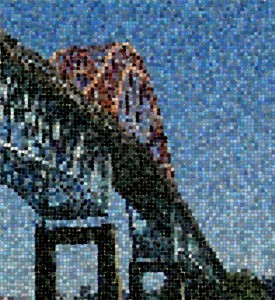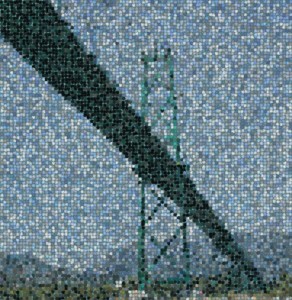The more I discuss the Pattullo issue with people, the more I find myself referring to the Lions Gate Bridge.
There are significant similarities. Both bridges were built in the mid 30’s; both connected an established (now Historic) part of the Lower Mainland to an expanding suburb, leading to the expansion of suburbs; both are immediately adjacent to historic parks; both are iconic structures that define the skyline of their region; both were supplanted from being the main crossing of their respective waterways in the early 1960s with the completion of the Trans-Canada Highway; and both have suffered from enough short-term thinking and neglect that their immediate replacement became a high priority.
So while we discuss the potential replacement of the Pattullo, it might be useful to look back at the history of the proposed replacement for the Lions Gate.
Just for context, this was back in the heady days of 1993-1994. The NDP formed government after an upstart right-of-centre party split off votes from a scandal-plagued government with a hapless place-keeper Premier, The Canucks lost in Game 7 of the Stanley Cup playoffs and riots ensued, and in the USA, a popular Democrat President was going into the re-election campaign after spending most of his first term cleaning up after the economic havoc the previous Republican administration had wrecked, partially through an unfunded war in Iraq. Times change.
I found an interesting source of info when researching the history of the Lions Gate, it is this Masters Thesis from the SFU Department of Geography, completed in 1998 (notably, more than a year before the actual bridge refurbishment project commenced). Doubly cool for me, as I was a student in Geography at SFU up to 1997, so I probably met this guy (it was pretty small department), although he was clearly on the “Human Geography” side, and I was over hanging with the dirt-and-rocks “Physical Geography” types.
The Thesis provides an excellently-referenced timeline (and time capsule) of the consultation process that went into the decision to refurbish the Lions Gate as opposed to replacing it, twinning it, or building a tunnel under Burrard Inlet. [NOTE: all quotes below are from this thesis].
The one remarkable part is how wide-reaching the consultation was. In contrast to the Pattullo “consultations” where New Westminster and Surrey were asked to comment on which colour of onramp we prefer,the Lion’s Gate discussion started in 1993 with a public call for proposals and ideas.
In 1993, the provincial government began its public consultation process. This involved informing the public about the project and gathering feedback at a number of stakeholder roundtables, open houses, debate sessions and a proponents’ showcase. The meetings began with presentations from technical experts about the possible routes and alternatives under consideration, followed by question periods. Panels made up of representatives from stakeholder groups and technical experts answered questions from the public. Interested people could also submit their opinions on paper at the meetings or by mail to the Lion’s Gate Bridge Public Information Center, which was located in Denman Place Mall until early in 1997. In total more than 1000 submissions were received.
Note, this was all before they had even chosen a shortlist of approaches to the problem posed by an aging bridge. There were no less than 21 alternatives seriously evaluated (including such things as replacing the bridge with a gondola, improving ferry service, and commuter train options). By 1994, these proposals have been whittled down through technical, stakeholder, and public review, to 8 options, ranging from just repairing the existing bridge to refurbishing the bridge, replacing it, twinning it, and no less than 3 different tunnel options. It seems the only thing missing was a serious discourse about the colours of the on-ramps.
By 1995, these options had been reduced to the 4 most favoured, some for technical reasons, some simply due to cost, and on the basis that the Province, the City, and the Park had agreed that any new replacement would be a 4-lane option. No more, no less.
Then things got political.
The four-lane-refurbish option was the clear favourite out of the consultation process. It was determined by the engineering team* that the bridge could be rehabilitated to carry the loads of 3, 4, or 6 lanes of traffic, with increasing cost for reinforcement as proposed loads went up. There was a significant public resistance to the idea of having a large increase in capacity, due to impacts on the park and neighbourhoods (at the time it was felt the traffic on the bridge was so “peaky” around rush hour that 4 lanes did not represent a significant increase in capacity over the existing three-lane-counterflow design).
However, for reasons that became obvious, the decision was not announced prior to the 1996 Election. That was the election that saw the Glen Clark NDP re-elected, at least partially due to what would become known as the “Fudge-it Budget”. Not long after the election, money got very tight, and the government’s appetite for spending was curtailed. The Government released the decision to pursue the 4-lane refurbish option in 1997, but due to financial constraints, floated the idea of using the new-fangled “Public-Private Partnership” model to finance it.
In a news release the Minister of Transportation and Highways, Lois Boone, stated she was seeking bids for a crossing that met the following conditions:
- The new crossing is to follow the existing First Narrows alignment from Marine Drive in North Vancouver to Georgia Street in Vancouver;
- Four fanes of traffic, two northbound and two southbound, but with surface traffic through Stanley ark reduced or eliminated;
- No net detrimental effect on Stanley Park;
- A plan to reduce traffic impacts on the West End;
- The province will invest up to $70 million over five years, which is the same amount as would be spent on a three-lane rehabilitation;
- Additional costs are to be financed from tolling revenues. (BCTFA 1997a)
This clearly shows the government’s commitment to improve the Lion’s Gate Bridge but not to pay for it.
In the end, the tolling option was not acceptable to the North Shore communities, so the PPP model fell apart. The Province finally tendered the work for $66 million in 1999, and with no PPP partner or tolls to pay for the structural upgrades required to build a 4-lane bridge, they instead took the more affordable option of the three wider lanes that could be afforded, and kept the counter-flow. Essentiually, those chose the second place finisher, based on costs alone.
However, this does not take away from the point that the entire evaluation process was transparent and involved extensive input from stakeholders and the public along the way. The communities at each end and stakeholders such as the Vancouver Parks Board and the Friends of Stanley Park had a real say in how the final design was achieved, the last-minute cheap-out by the Provincial Government notwithstanding. This is important: the last minute cheap-out was and acceptable option to the stakeholders, if not the preferred one to many.
How does this compare to the experience that New Westminster and Surrey have had at the TransLink consultation table for the Pattullo Bridge?

